The routes marked out by surveyors for railways in Devon couldn’t sometimes avoid inclines, several of which were severe. In steam days, this meant an additional loco, or pilot, was added to push or pull it over hilly areas, although by diesel days, with their increased power, the need had diminished somewhat. From Plymouth towards London there was first Hemerdon, rising up from Plymouth, then Rattery, which led down to Totnes, and finally Dainton descending to Newton Abbot. The slowdown or acceleration of a train you traveled on was a good warning of the presence of a bank, but with the HST, the transition was smoothed out somewhat.
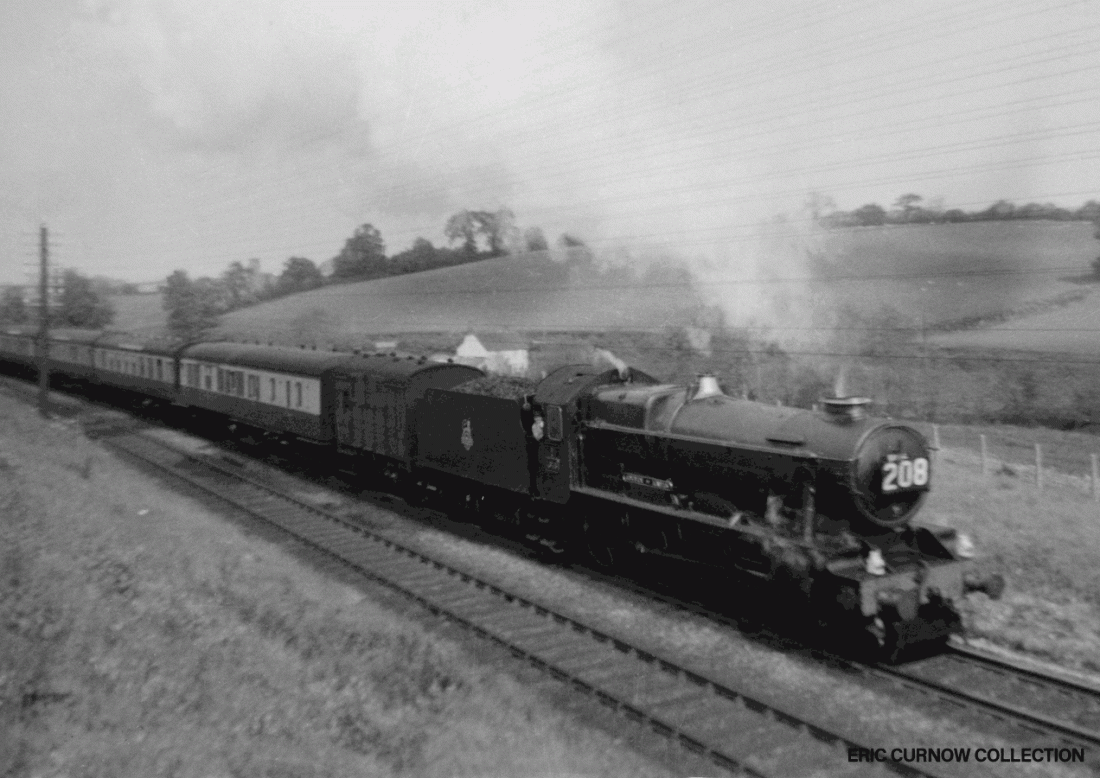
1016 ‘COUNTY OF HANTS’ ascends Whiteball with a Manchester-Penzance working – the Salop loco due to work through to Newton Abbot. It is in fine fettle, with gleaming name and numberplates – behind the tender is a horse box, and most carriages carry roof boards. 5####BD01-WHB-s1016-PASGR

Though her appearance might betray her, 4922 “ENVILLE HALL” steps out in confident form as it pilots D600 with the Down portion of ‘The Cornish Riviera’ on the eastern slope of Dainton Bank. A train of chocolate and cream coaches trails behind her as steam clings to them, then dissipates into the air. 5####BX01-DAI-s4922-PILOT

Presumably taken in Summer, as the Second Man leans through the window in short sleeves, D6300 pilots a steamer, oozing steam from multiple places, up one of the South Devon banks with a down express. The first of its class, D6300 is in original livery of green with red buffer beam. 5####CB01-UNK-D6300-PILOT
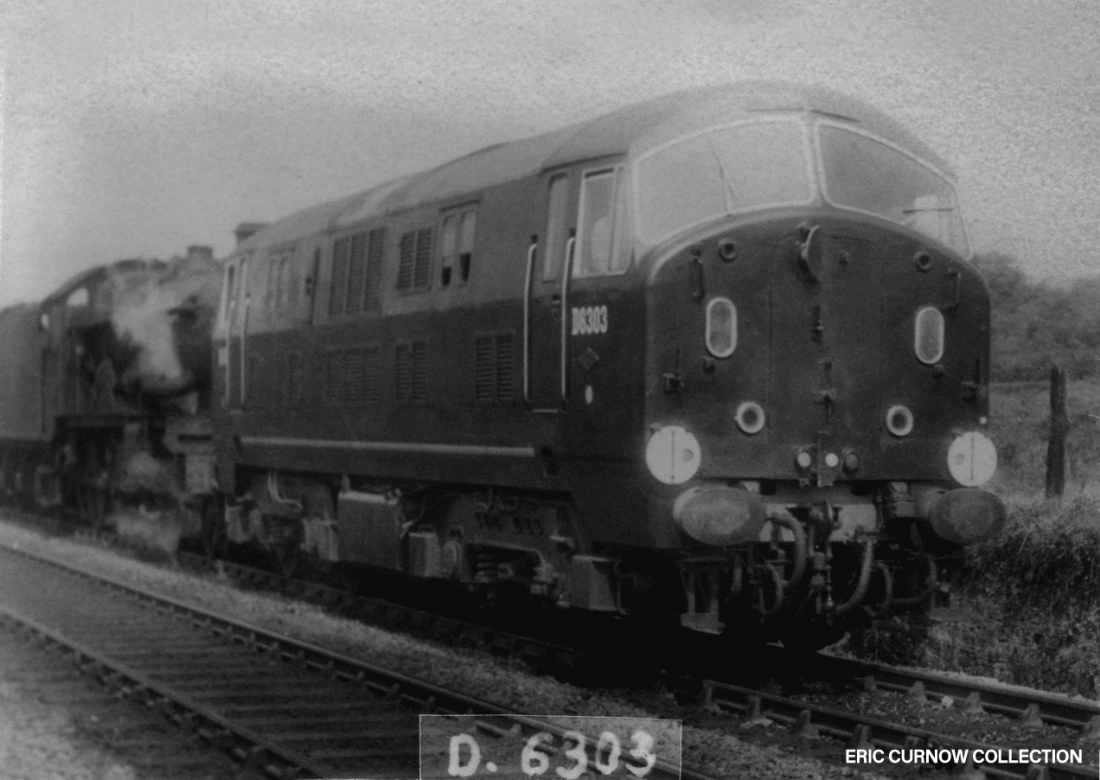
Another of the pre-production class, D6303, rises the same bank at the same location, also piloting a steamer. The central bodyside louvres were never replaced by a large radiator grille that the production versions were modified to, and had ventilation “eyebrows” above their windscreen windows. 5####CA01-UNK-D6303-PILOT

Newly placed in service, D806 “BENBOW” climbs the eastern slope of Rattery Bank with the down “Royal Duchy” service, looking every inch “Great Western” with it’s brunswick green livery, bright red buffer beam, headboard and white discs. Photo: D B Swale. 59###CG01-RTY—D806-PAS_D
 Believed to be on one of the Devon banks, a D8XX Warship is pilot on an eastbound train of maroon coaches, with a Royal Mail van next to the steam engine. The Warship is a Swindon-built example in original livery with small yellow warning panel. 6####CQ01-UNK–D8##-PASSR
Believed to be on one of the Devon banks, a D8XX Warship is pilot on an eastbound train of maroon coaches, with a Royal Mail van next to the steam engine. The Warship is a Swindon-built example in original livery with small yellow warning panel. 6####CQ01-UNK–D8##-PASSR

Hemerdon Bank is the first of three inclines going eastwards from Plymouth, and D6309 pilots 60XX “KING WILLIAM IV” with 13 coaches on at 11.20am heading the 8.15am Perranporth to Paddington, having just reached the summit. This shallow arc bridge is the closest of two close together near the watershed. 60###AC01-HEB-D6309-PILOT
 Enthusiasts in the first carriage shield their eyes against the sun and wind as D601, in original pristine livery, makes its way uphill towards Cornwall – the driver and second man aware of the photographer. An “up” train is signaled for the adjacent track. 6#####A01-DAI–D601-PAS_D
Enthusiasts in the first carriage shield their eyes against the sun and wind as D601, in original pristine livery, makes its way uphill towards Cornwall – the driver and second man aware of the photographer. An “up” train is signaled for the adjacent track. 6#####A01-DAI–D601-PAS_D
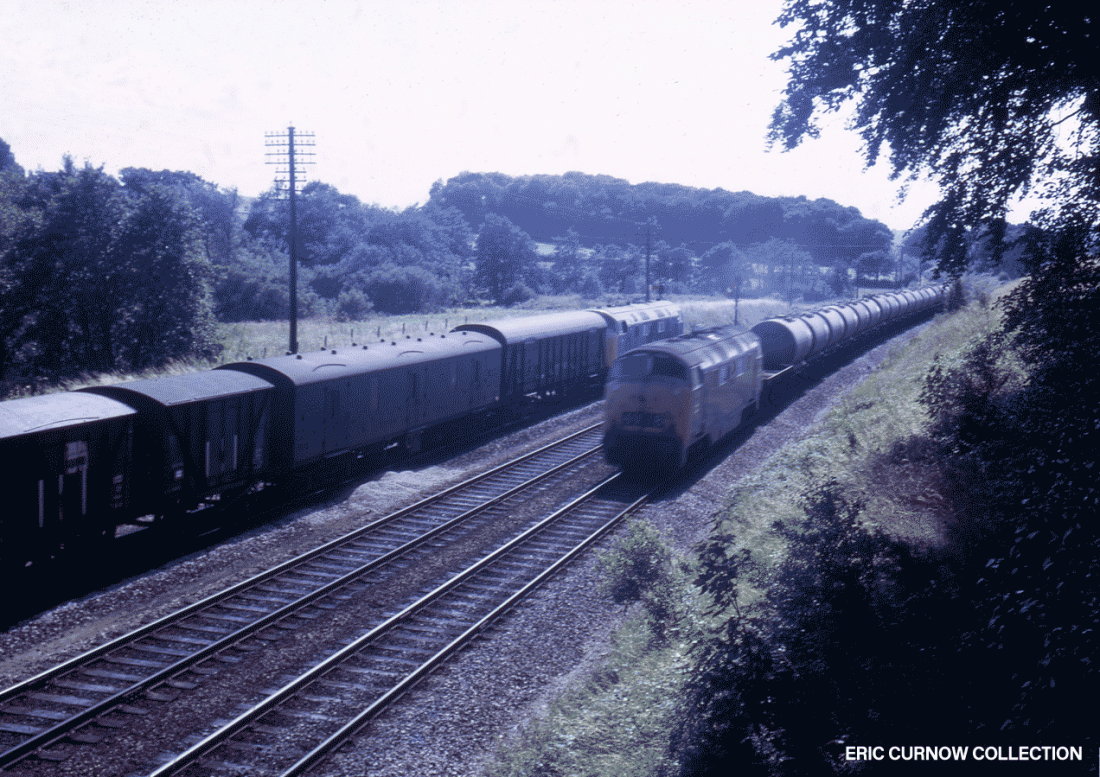
Warships’ pass each other on Whiteball summit as 825 “INTREPID” breasts the rise with a rather heavy train of oil tanks and 808 “CENTAUR” waits in the loop for a passenger service to pass. “CENTAUR” is in single logo livery, and INTREPID, double emblems. 7007#AC01-WHB—D808-TNKS
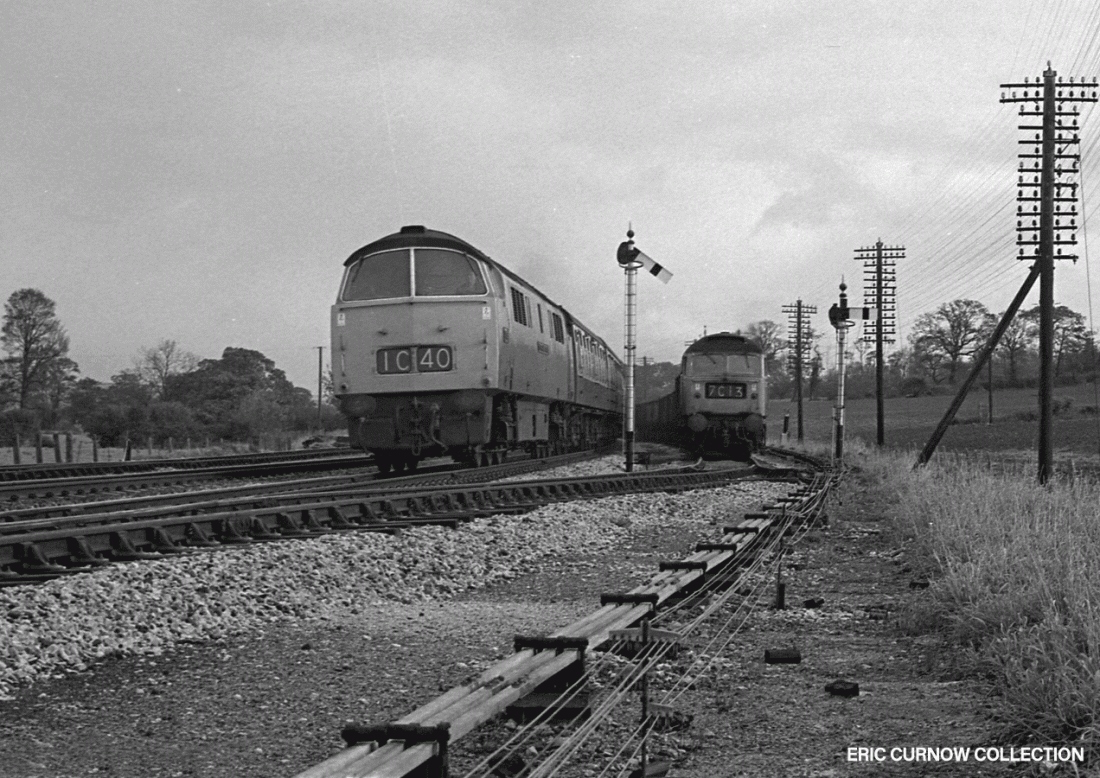
A Class 47 on a goods turn waits for the road in Whiteball loop while a ‘Western’ with a down Mk I train passes steadily on towards the West. Rods and wires show the signal box is close and the telegraph poles are rather more heavily loaded with cables than was the norm. 7####CZ01-UNK-D10##-PAS_D
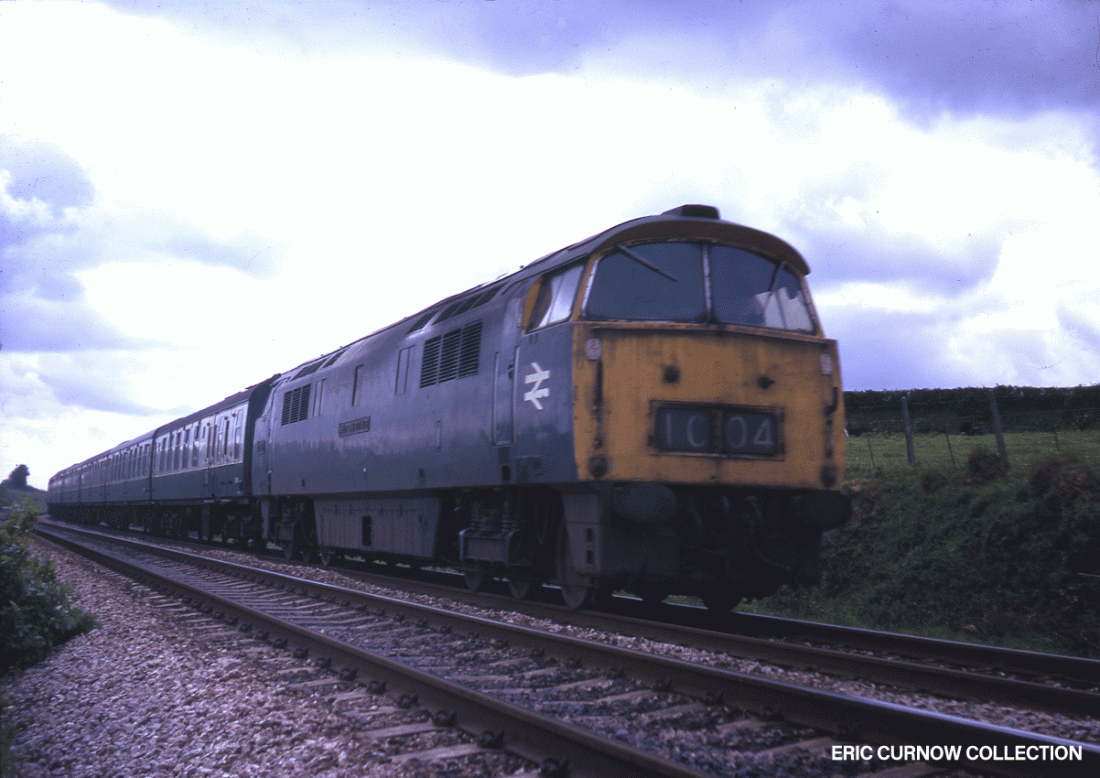
On 8th June 1974 D1041 “WESTERN PRINCE” runs eastwards away from the top of Hemerdon Bank with a Paddington-bound service of Mk I carriages, that blend nicely with the loco. In the lee of the hedge behind the train, one or two Fresians turn their heads. 740608A01-UNK-D1041-PASGR
 D1015 “WESTERN CHAMPION” storms up the bank in sylvian country viewed from the shadow side as the sun gets low in the sky. An automatic signal lies ahead and a pylon interrupts the pastoral scene, though its delicate tracery avoids it becoming an eyesore. 7####BT07-DAI-D1015-PAS_U
D1015 “WESTERN CHAMPION” storms up the bank in sylvian country viewed from the shadow side as the sun gets low in the sky. An automatic signal lies ahead and a pylon interrupts the pastoral scene, though its delicate tracery avoids it becoming an eyesore. 7####BT07-DAI-D1015-PAS_U
 D1015 “WESTERN CHAMPION” nears the top of Dainton bank from the west, passing under the footbridge before the summit. There is a Syphon G and a GUV between the photographer and the loco, and the track sides have been selectively ballasted. 7####BR02-DAI-D1015-PAS_U
D1015 “WESTERN CHAMPION” nears the top of Dainton bank from the west, passing under the footbridge before the summit. There is a Syphon G and a GUV between the photographer and the loco, and the track sides have been selectively ballasted. 7####BR02-DAI-D1015-PAS_U
 Passing the site of the former “up” refuge siding, now lifted though the earthworks remain, D1015 “WESTERN CHAMPION” is about to enter Dainton Tunnel. Signal trunking is in the cess along with signal wire for semaphores, soon to be made redundant. 7####BU05-DAI-D1015-PAS_U
Passing the site of the former “up” refuge siding, now lifted though the earthworks remain, D1015 “WESTERN CHAMPION” is about to enter Dainton Tunnel. Signal trunking is in the cess along with signal wire for semaphores, soon to be made redundant. 7####BU05-DAI-D1015-PAS_U
 As an up service approaches the crest of Dainton Bank and into the tunnel, all eyes in the cab of a down service adjacent – just burst into the sunlight – are focused down line. The signal man in the box beside them stands in the shade, watching. 7####DW01-DAI-D10##-PAS_D
As an up service approaches the crest of Dainton Bank and into the tunnel, all eyes in the cab of a down service adjacent – just burst into the sunlight – are focused down line. The signal man in the box beside them stands in the shade, watching. 7####DW01-DAI-D10##-PAS_D
 A Western growls up the eastern incline towards Dainton Tunnel with a down passenger service amid beautiful countryside on a fine day in 1969. With the exception of the first carriage in maroon, the other Mk 1s have been repainted in blue and grey. 680730E01-DAI-D10##-PAS_D
A Western growls up the eastern incline towards Dainton Tunnel with a down passenger service amid beautiful countryside on a fine day in 1969. With the exception of the first carriage in maroon, the other Mk 1s have been repainted in blue and grey. 680730E01-DAI-D10##-PAS_D
 Emerging into the daylight from Dainton Tunnel, 47055 dips downhill westwards with a train of Mk I carriages. The wet sleepers under the tunnel suggest a persistent dampness there, and the former trackbed to the right is being encroached by undergrowth. 7####CX04-DAI-47055-PAS_D
Emerging into the daylight from Dainton Tunnel, 47055 dips downhill westwards with a train of Mk I carriages. The wet sleepers under the tunnel suggest a persistent dampness there, and the former trackbed to the right is being encroached by undergrowth. 7####CX04-DAI-47055-PAS_D
 Crawling towards the watershed within Dainton Tunnel, an up service headed by a Western passes the signal box at this isolated spot. By 1969, the refuge sidings on the left have been largely lifted, but that on the right remains – just in case it is needed. 68###AE03-DAI-D10##-PAS_U
Crawling towards the watershed within Dainton Tunnel, an up service headed by a Western passes the signal box at this isolated spot. By 1969, the refuge sidings on the left have been largely lifted, but that on the right remains – just in case it is needed. 68###AE03-DAI-D10##-PAS_U
 A Western in maroon livery, its roofline encrusted in exhaust residue, passes Dainton Box with a down express – the carriage carrying a waistline level destination board. A redundant track panel marks the former access to the down refuge sidings. 690409A01-DAI-D10##-PAS_D
A Western in maroon livery, its roofline encrusted in exhaust residue, passes Dainton Box with a down express – the carriage carrying a waistline level destination board. A redundant track panel marks the former access to the down refuge sidings. 690409A01-DAI-D10##-PAS_D

Red-backed nameplate 47087 “SIR DANIEL GOOCH” runs down Hemerdon Bank towards Plymouth with the 10.56 SO 1B49 Paddington-Penzance service on 7th June 1975 – caught skillfully by the photographer. This loco was one of 17 diesel-electrics to carry names associated with the Great Western. 750607-HEM-47078-PAS_D
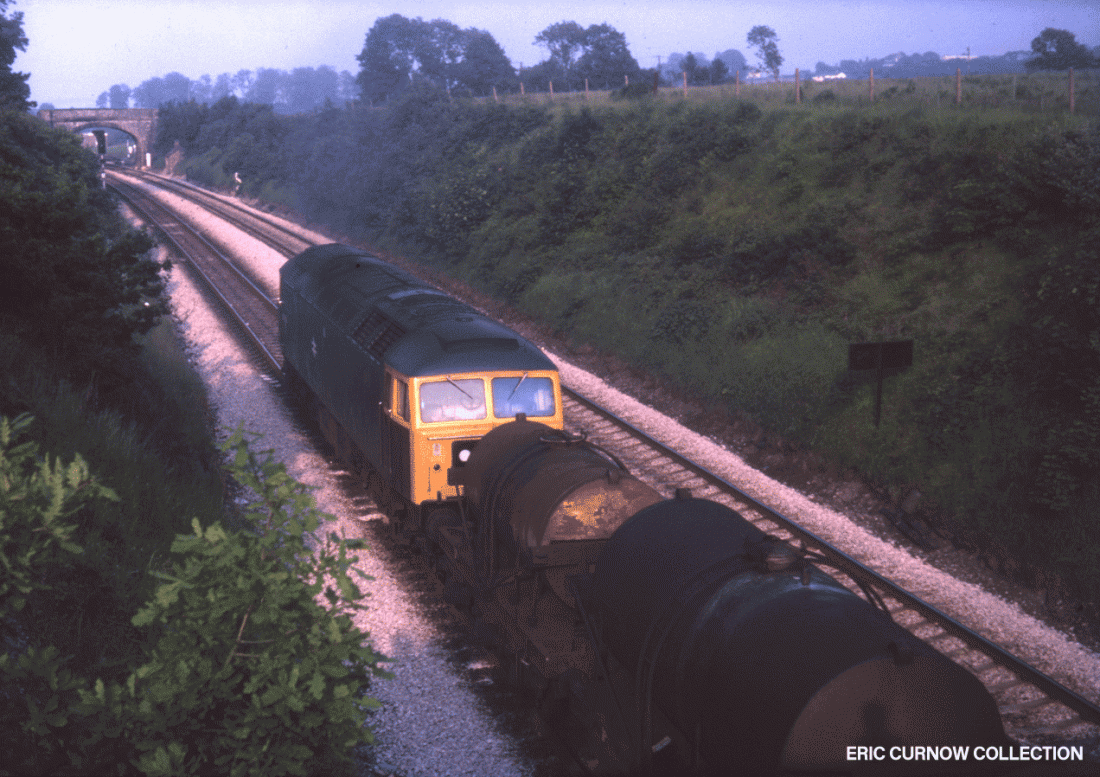
47138 nears the summit of Hemerdon Bank with the 16:40 St Erth to Acton Milk on 20th June 1979. The oil-staining of the uphill trackbed shows slower travel compared to that opposite where trains would cruise down. A sign to pin down brakes still remains in situ. 790620A01-HEB-47138-MIL_U

Sequentially-numbered D1046 “WESTERN MARQUIS” and D1047 “WESTERN LORD” are halted by a Pilot Man near Totnes on 16th February 1969. “LORD” has a blue hue sufficiently different from the standard that led me to believe one such sighting was a green-liveried Western. Photo: Bill Kerry. 690216B01-TOT-D1046-PASGR
 Viewed from a train opposite, a long train of vans has descended the bank west of Totnes behind D844 “SPARTAN” in matching unkempt appearance. The two additional tracks between the platform were for through trains and banking locos. Photo: Peter Noonan. 6##999A01-TOT–D844-PAS_D
Viewed from a train opposite, a long train of vans has descended the bank west of Totnes behind D844 “SPARTAN” in matching unkempt appearance. The two additional tracks between the platform were for through trains and banking locos. Photo: Peter Noonan. 6##999A01-TOT–D844-PAS_D

At Treverrin east of Par, 47052 heads a six coach 14.40 Penzance to Paddington passenger service sometime in 1974. It still has an operational and neatly configured headcode panel, and is in original two-tone green livery. Telegraph wires rise ahead of it indicating the closeness of the portal of the tunnel – the vantage point for the photographer. 740822A01-UNK-47052-PAS_U
 In the fashion that impressed my father, HST set 253006 tops Hemerdon Bank with a 1A49 SuX 09.33 Penzance to Paddington service. Beside it vegetation has been burned back, yet the signal seems unscathed. I’ve always admired the coach livery that gave such broad bands of colour for the carriage types. 830827A01-HEM-43012-PAS_U
In the fashion that impressed my father, HST set 253006 tops Hemerdon Bank with a 1A49 SuX 09.33 Penzance to Paddington service. Beside it vegetation has been burned back, yet the signal seems unscathed. I’ve always admired the coach livery that gave such broad bands of colour for the carriage types. 830827A01-HEM-43012-PAS_U